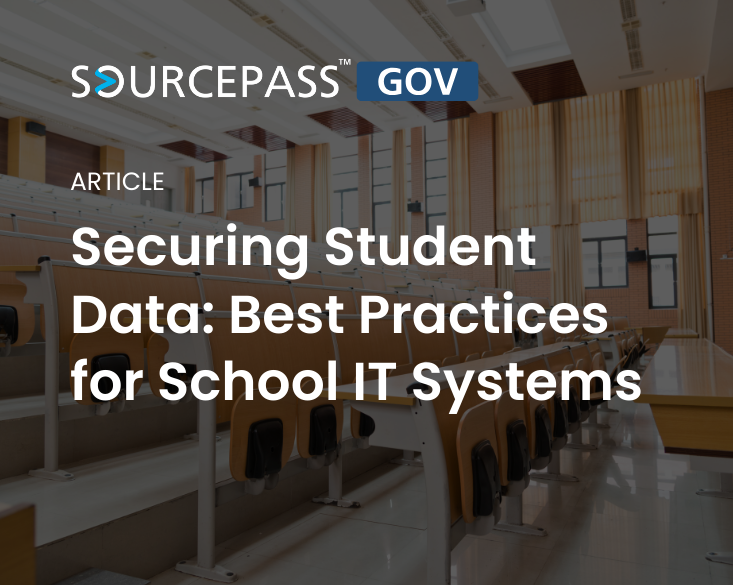1 min read
AI for the Public Sector | Sourcepass GOV AI Trainings
Artificial Intelligence (AI) is transforming how public sector organizations operate, from budgeting and compliance to citizen engagement. In our...
4 min read
Alex Davis : Feb 10, 2025 8:00:00 AM

In 2025, higher education institutions face the dual challenge of providing cutting-edge technology solutions while maintaining robust, secure IT infrastructures.
The right IT strategy can enable universities and colleges to improve teaching and learning, streamline administrative processes, and enhance the overall student experience.
However, creating an effective IT strategy in higher education requires careful planning, stakeholder collaboration, and a deep understanding of both current and future needs.
In this step-by-step guide, get key steps to help higher education institutions develop an IT strategy that aligns with their goals and meets the demands of the modern academic environment.
Before diving into technical solutions or hardware considerations, it’s essential to understand the overall mission and goals of the institution. The IT strategy should align with the broader institutional objectives and help support the vision for the future.
For example, if an institution prioritizes online learning and remote education, the IT strategy must focus on ensuring robust virtual learning environments, user-friendly platforms, and secure data handling. Similarly, if a university focuses on research, IT investments should prioritize high-performance computing resources, data storage, and collaboration tools.
An effective IT strategy starts with a comprehensive assessment of the current state of technology within the institution.
This includes evaluating existing systems, understanding the needs of faculty, students, and administrative staff, and identifying potential gaps or inefficiencies.
Key areas to assess include:
By conducting this audit, institutions can gain a clear understanding of what works well and what needs improvement.
Cloud technology has revolutionized IT in higher education by offering scalable, flexible, and cost-effective solutions. Whether it's hosting learning management systems (LMS), managing student data, or enabling remote learning, cloud solutions can provide the infrastructure needed to support diverse educational environments.
When building an IT strategy, consider a hybrid cloud approach, which combines on-premise and cloud-based solutions. This allows institutions to maintain control over sensitive data while taking advantage of the scalability and cost savings of cloud services.
For instance, universities may choose to store sensitive student records on secure servers while utilizing cloud-based collaboration tools and storage for other administrative functions.
.png?width=2250&height=1250&name=Sourcepass%20Featured%20Blogs%20(8).png)
With the growing reliance on digital tools, data security and privacy have become paramount in higher education IT strategies. Institutions must take a proactive approach to protecting student, faculty, and institutional data.
Key actions include:
Creating a culture of cybersecurity awareness among faculty, staff, and students is also crucial. Regular training sessions and updates on best practices for data security should be mandatory.
An effective IT strategy in higher education must be future-proof. The technology landscape is constantly evolving, and institutions need to ensure that their IT systems are scalable and flexible to adapt to new challenges, trends, and technological advancements.
For example, the shift to hybrid and online learning environments requires infrastructure that can handle the increased demand for remote access, video conferencing, and collaboration tools. IT systems should be designed to scale seamlessly as student enrollment and course offerings grow. This includes having scalable storage, network bandwidth, and computing resources.
Additionally, flexibility in terms of software and hardware allows the institution to pivot quickly when new tools or solutions become necessary. Implementing modular solutions that can be easily updated or expanded can save time and money in the long run.
Collaboration is key to fostering a dynamic academic environment, and technology plays an important role in facilitating it.
Whether it’s for faculty working on research projects, students collaborating on group assignments, or administrative teams coordinating daily operations, IT systems should provide efficient communication and collaboration tools.
Consider integrating solutions such as:
Providing these tools not only enhances productivity but also creates a more engaging and interactive learning experience for all involved.
A successful IT strategy relies heavily on the expertise of the institution’s IT staff. It’s crucial to invest in continuous professional development and training to ensure that your team remains skilled in the latest technologies and best practices.
Offer opportunities for IT staff to attend workshops, certifications, and conferences that focus on higher education IT trends and emerging technologies. Keeping staff up-to-date with new advancements ensures that the institution’s IT systems are in line with industry standards and capable of supporting a wide range of academic and administrative needs.
Building an IT strategy is not just the responsibility of the IT department. It’s essential to engage key stakeholders—faculty, students, administrators, and even alumni—in the planning and decision-making process. These stakeholders can provide valuable insights into the specific needs and challenges that must be addressed.
For example, faculty members may have unique requirements for teaching tools or access to research data, while students may need more user-friendly mobile apps for accessing course materials. Involving stakeholders early ensures that the IT strategy aligns with the needs of the entire institution.
Once the IT strategy is implemented, it’s important to establish metrics for success. These could include:
Regular evaluations allow for adjustments and improvements to be made, ensuring that the strategy remains aligned with the institution's evolving needs.
Creating an effective IT strategy for higher education is a complex but essential task that can significantly enhance the academic experience, improve operational efficiency, and ensure data security.
Stay ahead of technology trends with Sourcepass GOV. Speak with an expert today to learn more about what's possible for higher education organizations.
.png)
1 min read
Artificial Intelligence (AI) is transforming how public sector organizations operate, from budgeting and compliance to citizen engagement. In our...

3 min read
More than halfway through 2025, state Chief Information Officers (CIOs) continue to navigate a dynamic landscape of technological advancements and...

2 min read
Protecting student data is a top priority for school districts. New York's Education Law §2-d, enacted during the 2014-2015 fiscal year, sets forth...

In the age of hybrid and virtual learning, schools have become increasingly reliant on technology to enhance learning, improve administrative...

As technology continues to evolve, so too must the way we approach education. In today’s world, integrating technology into the classroom isn’t just...

From the way students engage with course materials to how teachers deliver lessons, the digital revolution has already changed how education is...